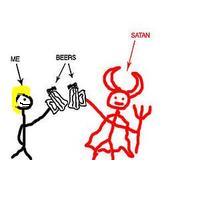Poetic, no. But perfect in its geo/temporal data. It's Moscow, 1876. The rule of Romanov Tsar Alexander II (he would be assassinated in 1881 after decades of various attempts on his life. He was famous for freeing the serfs but was a bastard to Poland and the Baltic States. However, he encouraged Finnish autonomy and language so they like him there. The poor son of a bitch died after escaping a bombing attempt on his carriage. A second bomber threw a bomb at his feet. There was a third bomber waiting in the crowd. They really wanted him dead, in little pieces.) He was followed by only two more Tsars: Alexander III and then Nicholas II.
The book opens at any rate with a suspicious suicide in the Alexander Gardens in Moscow. This was one of Moscow's first public parks. It was built from 1819-1823 in commemoration of the defeat of Napoleon at the request (or, probably I should say "request") of Alexander I, the uncle of the ill-fated Alexander II. The Gardens are adjacent to Red Square and the western wall of the Kremlin.
Here is the gate that commemorates victory in the Napoleonic Wars:
It was built on the site of a the former riverbed of the Neglinnaya River (the flow was diverted underground.)
Enjoy this Wikimap of the layout.
The book references a "Table of Ranks" at the back to show the standing of the protagonist, Collegiate Registrar Erast Fandorin, rank 14, as compared with others. It's a convoluted system established by Peter the Great in 1722. Among other things, it correlates military ranks with the civilian equivalents.
Many streets in Moscow are mentioned so, once again, I would have liked a map to be available. Fandorin travels up Mokhovaya Street a number of times. Here is what it would have looked like then:
It literally means "Moss Street" and was named for a market. It is still a major thoroughfare in Moscow. It's part of the ring road that circles the Kremlin area.
I believe the university he mentions visiting is Moscow State, purported to be the oldest university in Russia. Here is what it would have looked like about a century before:
I think the "yellow building" that Fandorin goes to is what is now called, factually, the Old Building. It was built in 1783. Here's what it looks like now:
Old, yellow. Those Russians get right to the point. Today, the journalism faculty and Oriental studies are located there.
Interestingly, after the October Revolution in 1917, anyone could be admitted (well, technically) and tuition fees were abolished in 1919. Now all you had to do was avoid studying or teaching the wrong thing and being sent to Vorkuta.
This site has an archive of historical maps. Here is one of 19th century Moskva.
Near the end, the book mentions there is trouble in the Balkans that is distracting the leadership. I think they are referring to the Balkan/Turkish crisis. The Balkans, including Greece, were under Ottoman rule at the time. The Slavs all hated each other but they hated the Turks more so they banded together in the Bulgarian Uprising in April of 1876 where Turkish troops killed up to 15,000 people (it's controversial-apparently the troops weren't regular Turkish army.) It was nasty business at any rate-people taking refuge in churches and being burned alive- and things snowball, the world gets wind of the Bulgarian massacre, the Russians are still pissed about the Crimean War, Slav nationalism flares up and by June Serbia and Montenegro have declared war on the Turks.
The Russians proposed a peace agreement in 1877 called the London Convention (Austria-Hungary are involved too) but the Turks rejected it. Now the Russians declare war. The bottom line is the Turks, being neither the first nor last to do so, severely underestimate the Russians and finally in 1878 peace is declared with some intervention from the British as the fear of Pan-Slavic fervor spreads through the rest of Europe. At the Congress of Berlin, the Balkans get re-diced with Bulgaria split into 3 pieces and Austria granted the right to occupy Bosnia and Herzegovina. All of this pisses Russia off because they want the Balkans for themselves. A Second Balkan Crisis will follow in 1885 and, of course, there will be more.
Incidentally, this conflict also led to the Red Cross/Red Crescent split which continues today.
At the end of the book, before everything goes to hell for Erast, he is awarded the order of St. Vladimir. Naturally, there is a website dedicated to Russian medals. Here is an example of what it looked like:
It was awarded for life-saving acts or famine relief (it was also awarded for military valor during the Crimean War.) There are different degrees of the order which can be seen in the Wikipedia article.






No comments:
Post a Comment